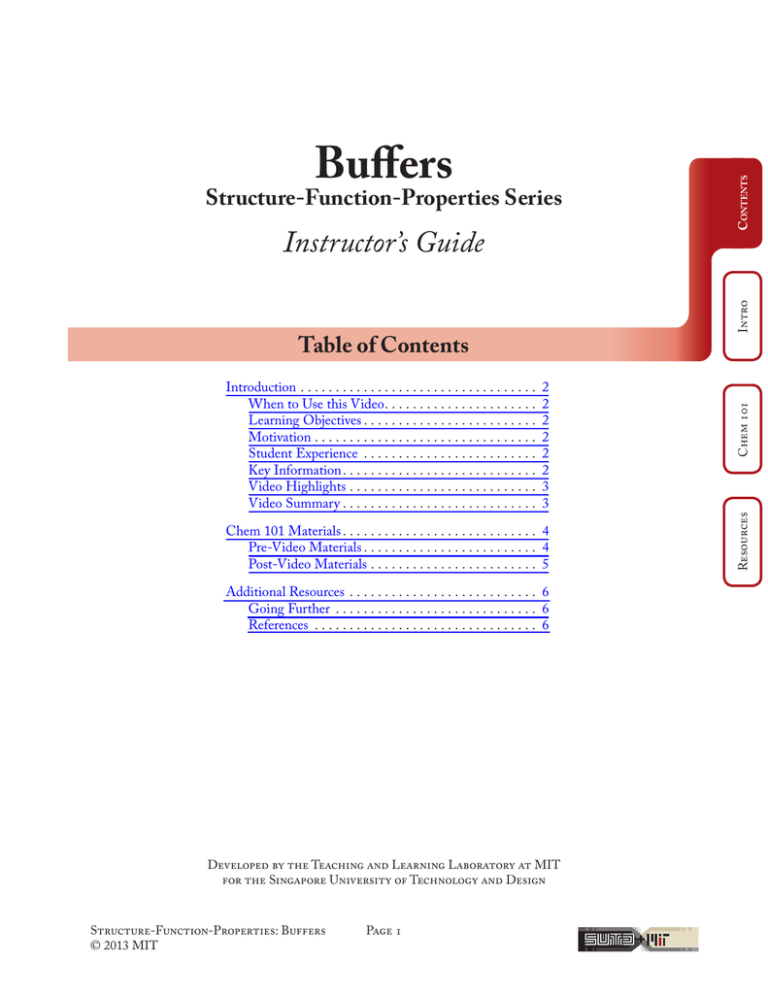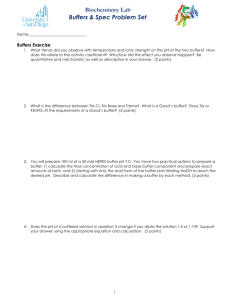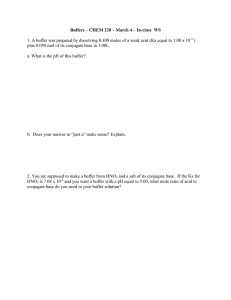Buffers Instructor’s Guide Structure-Function-Properties Series Table of Contents
advertisement

Contents Contents Buffers Structure-Function-Properties Series Intro Instructor’s Guide Table of Contents Chem 101 2 2 2 2 2 2 3 3 Resources Introduction. . . . . . . . . . . . . . . . . . . . . . . . . . . . . . . . . . . When to Use this Video. . . . . . . . . . . . . . . . . . . . . . . Learning Objectives. . . . . . . . . . . . . . . . . . . . . . . . . . Motivation. . . . . . . . . . . . . . . . . . . . . . . . . . . . . . . . . Student Experience . . . . . . . . . . . . . . . . . . . . . . . . . . Key Information. . . . . . . . . . . . . . . . . . . . . . . . . . . . . Video Highlights. . . . . . . . . . . . . . . . . . . . . . . . . . . . Video Summary. . . . . . . . . . . . . . . . . . . . . . . . . . . . . Chem 101 Materials. . . . . . . . . . . . . . . . . . . . . . . . . . . . . 4 Pre-Video Materials. . . . . . . . . . . . . . . . . . . . . . . . . . 4 Post-Video Materials. . . . . . . . . . . . . . . . . . . . . . . . . 5 Additional Resources . . . . . . . . . . . . . . . . . . . . . . . . . . . . 6 Going Further . . . . . . . . . . . . . . . . . . . . . . . . . . . . . . 6 References . . . . . . . . . . . . . . . . . . . . . . . . . . . . . . . . . 6 Developed by the Teaching and Learning Laboratory at MIT for the Singapore University of Technology and Design Structure-Function-Properties: Buffers © 2013 MIT Page 1 + Introduction • In Chem 101, at home, in class, or in recitation, before or during Lectures 26 and 27. Prior knowledge: Students should have a basic understanding of chemical equilibria; know how to calculate the pH of acid-base solutions. Learning Objectives Duration: 17:30 Narrator: George Zaidan Materials Needed: • paper • pencil • Legos® (optional) After watching this video students will be able to: • • Describe how the structure, or composition, of a buffer functions to resist changes in pH. Contents • Key Information Intro Intro When to Use this Video Explain how the choices made in buffer design impact the properties of a buffer. Students often focus on the calculations related to buffers without thinking about how the various components of a buffer work together. As a result, they often show a poor understanding of the various factors that can influence the final properties of a buffer solution. Chem 101 Motivation It is highly recommended that the video is paused when prompted so that students are able to attempt the activities on their own and then check their solutions against the video. During the video, students will: • • • • • • Explain why a solution comprised solely of an acid in water could not effectively resist changes to its pH when more acid is added. Explain why a solution of a strong acid and a strong base will not resist changes in pH. Write the equilibrium expression for a weak acid. Evaluate the ability of a solution of a weak acid and strong base to create an effective buffer. Brainstorm factors that should be considered when designing a buffer solution. Consider how the ratio of weak acid to conjugate base will affect the buffering capacity of a solution. Structure-Function-Properties: Buffers © 2013 MIT Page 2 Resources Student Experience Video Highlights Legos® model of buffer solution Combination of strong acid (HCl) and strong base (NaOH) 7:26 Weak acid (HA) and strong base (NaOH): Introduction Student Activity 7:47 8:13 12:41 Weak acid (HA) and strong base (NaOH): Dissociation of HA Weak acid (HA) and strong base (NaOH): Addition of strong base Chapter 2: Buffer Design 13:30 Student Activity 16:26 Summary of the main factors crucial to buffer design 8:56 Video Summary In this video, Legos® are used to create possible molecular level models of a buffer. This is done to better understand how a buffer works and the components a buffer must contain in order to be effective. Students evaluate these models against a set of criteria determined at the beginning of the video and then consider other parameters that must be taken into account when designing a buffer. Structure-Function-Properties: Buffers © 2013 MIT Page 3 Intro Intro 5:18 5:56 Comments Students are introduced to a conceptual model of buffer solutions based on Legos®. Introduction to Lego® model. Legos® are used to model the complete dissociation of a strong acid and base and their subsequent neutralization reaction. Legos® are used to model the reaction between a weak acid and strong base. Students will determine the equilibrium expression for three different weak acids. Legos® are used to model the partial dissociation of a weak acid (HA) in water. Legos® are used to model the effect of a strong base on a weak acid solution. Students are introduced to buffer capacity and the factors that influence buffer properties. Students are asked to list the factors they should consider when designing a buffer. Chem 101 Feature Chapter 1: Making a Model Resources Time 2:22 Contents This table outlines a collection of activities and important ideas from the video. Chem 101 Materials 1. Using Legos®, model solutions of a strong and weak acid and a strong and weak base. Have students review the definition of acids and bases and the differences between strong and weak acids and bases. 2. Amphoteric molecules (a) Identify the acid and base in the following reactions: • • HCO3-(aq) + H2O(l) ↔ H3O+(aq) + CO3-2 (aq) HCO3-(aq) + H2O(l) ↔ H2CO3(aq) + OH-(aq) (b) Discuss the nature of amphoteric molecules such as HCO3- and H2O, which can function as either acids or bases depending on the reaction conditions. Emphasize the importance of writing out the chemical reaction and identifying the acids, bases, and their conjugates. Chem Chem 101 3. The Ka of acid A is 1.8 x 10-5. The pKa of acid B is 2.2. Which is the stronger acid? 4. X moles of acetic acid (pKa 4.76) are dissolved in 100 mL of water to form solution A. Y moles of hydrochloric acid are dissolved in 100 mL of water to form solution B. The pH of solutions A and B are the same. What can you say about the quantities X and Y? Structure-Function-Properties: Buffers © 2013 MIT Page 4 Resources Intro When appropriate, this guide is accompanied by additional materials to aid in the delivery of some of the following activities and discussions. Contents Pre-Video Materials 1. Using Legos®, model a buffer solution of a weak base and its conjugate acid, and determine what happens upon the addition of a strong acid or a strong base. Then, model a real-life buffer system, such as the carbonic acid buffer system in the blood. Problems 2-4 are adapted from the Buffers Module developed by the MIT Council on Educational Technology (MICET) Chemistry Bridge Project. Contents Post-Video Materials (a) In a buffer system, the conjugate base is a H+ source that counteracts addition of strong acid. (b) In a buffer system, the acid is a H+ source that counteracts addition of strong acid. Intro 2. Which of the following is true? (c) In a buffer system, the acid is a H+ source that counteracts addition of strong base. 3. Buffer A has an equilibrium [acid]:[conjugate base] ratio of 4:1. Buffer B has an equilibrium [acid]:[conjugate base] ratio of 1:1. Which buffer will hold its pH better when 1 mL of 0.100M HCl is added? 4. Which of the following is not an appropriate way to make a buffer solution? (a) Prepare a solution of a weak acid with its conjugate base in approximately equal concentrations. (b) Partially titrate a weak acid with strong base. (c) Partially titrate a weak base with a strong acid. (d) Prepare a solution of strong acid with its conjugate base in approximately equal concentrations. (e) For the following equilibrium, addition of HCl will result in increased formation of what? CH3COOH(aq) ↔ CH3COO-(aq) + H+(aq) Structure-Function-Properties: Buffers © 2013 MIT Page 5 Resources Chem Chem 101 (d) In a buffer system, the conjugate base is a OH- source that counteracts addition of strong base. Additional Resources References The following articles provide an excellent introduction to the teaching and learning challenges related to buffers: • Orgill, M.K. and Sutherland, A. (2008). Undergraduate chemistry students’ perceptions of and misconceptions about buffers and buffer problems. Chem. Educ. Res. Pract. 9, 131-143. Tyson, L. and Treagust, D.F. (1999). The Complexity of Teaching and Learning Chemical Equilibrium. J. Chem. Ed. 76 (4), 554-558. The following MIT OCW video lecture discusses buffers: • Drennan, Catherine, and Elizabeth Taylor. 5.111 Principles of Chemical Science, Fall 2008. (MIT OpenCourseWare: Massachusetts Institute of Technology), http://ocw.mit.edu/ courses/chemistry/5-111-principles-of-chemical-science-fall-2008 (Accessed 6 Jan, 2014). License: Creative Commons BY-NC-SA -Lecture 22: Chemical and Biological Buffers Structure-Function-Properties: Buffers © 2013 MIT Page 6 Chem 101 • Cheung, D. (2009). The Adverse Effects of Le Chatelier’s Principle on Teacher Understanding of Chemical Equilibrium. J Chem. Ed. 86 (4), 514-518. Resources Resources • Intro Buffers play extremely important roles in chemical, biological, and biochemical systems, as well as in scientific research. For example, serious medical conditions, such as organ failure, can arise from the disruption and failure of the body to maintain a narrow pH range in the blood. Furthermore, students that continue in research will likely experience making a buffered solution. Students should begin to recognize how buffers are used in a wide range of applications and how appropriate buffer design contributes to the overall success of a particular process. Contents Going Further MIT OpenCourseWare http://ocw.mit.edu RES.TLL.004 STEM Concept Videos Fall 2013 For information about citing these materials or our Terms of Use, visit: http://ocw.mit.edu/terms.






